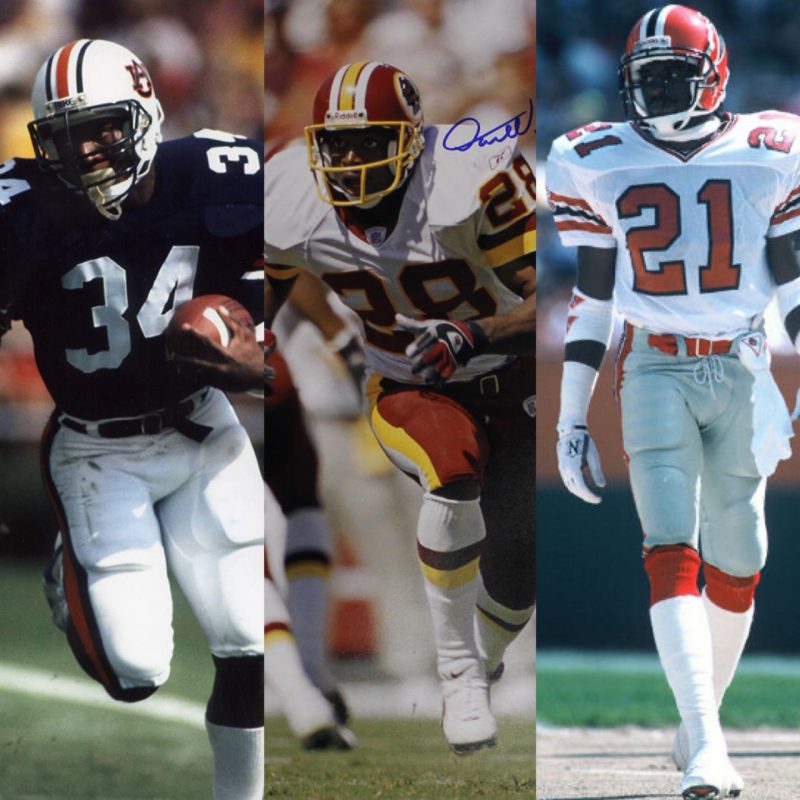By: Chad Wilson – Editor – GridironStuds Blog
Twitter: @GridironStuds
The 2017 NFL combine just passed a week ago and for the last seven days, NFL football fans and the media personnel that play up to them have discussed the 40 yard dash times of the prospects ad nauseam. Yes, we all know the obsession over 40 yard dash times can reach epic proportions but can something talked about so much be very misunderstood? The answer is yes.
Training and 3 Point Stances
I’ve had the pleasure of watching the greatest wide receiver of all time, Jerry Rice and the greatest cornerback of all time, Deion Sanders play their entire careers. I mention these two positions because these are the times that most fans and media obsess over. The time during which wide receivers lined up in three point stances has long passed. The practice of lining up in a 3 point stance as a wide receiver had made it’s way out of the NFL game by the time Jerry Rice stepped on the scene in 1984. As part of his audition for the NFL in ’84, Jerry Rice, like all other prospects, was asked to run a 40 yard dash and come out of a three point stance. As we all know by now, Rice’s time (4.7) was not ideal and people questioned his ability to be an elite NFL wide receiver. In a short sprint like the 40 yard dash, technique is of the utmost importance. Negotiating your way out of a three point stance and into proper running form while making maximum use of your push forces is just about everything. Choose the wrong stance or make some false steps and your time will look like a retired busy street prostitute without her make up on.
Deion Sanders, nor any cornerback before or since him has lined up in a 3 point stance to play the game. Two guys of equal speed with varying amounts of work, experience and training in sprinting from a three point stance will have different results on a stopwatch at the end of a 40 yard dash. An extremely technically sound track athlete who has spent a great deal of amount of time coming out of blocks and three point stances will have an edge in this drill. Many scouts will use the 40 yard dash just as a judge of a prospects athleticism. What this means is, the time may not be as important as how the prospect looked running the 40. Other scouts and GMs will cave to the pressure of making a decision on a prospect based on the number on the page because they feel they must cater to their fan base. What’s important to remember here is that much of the time of a 40 yard dash has to do with something that never occurs in the life of a wide receiver or defensive back and that is sprinting out of a three point stance.
40 Yards vs. 100 meters
Common fans without knowledge of track, speed and how it works will often confuse 100 meter success with 40 yard dash times. Often fans will feel that a prospect with fast sub 11 second 100 meter dash times should be a sub 4.4 blazer in the 100 meters. They also feel that any guy that can’t break 11 seconds in a 100 meter sprint can run 4.5 or better in the 40 yard dash. This is not necessarily correct.
Success in the 100 meters is often tied into the participant’s ability to achieve top speed and hold it for a significant period of time (speed endurance). What people mistakingly feel is happening when they see someone moving past someone else towards the end of 100 meters is the athlete accelerating. This is not the case. What is happening at the end of a 100 meter sprint are varying degrees of deceleration. Some athletes either through training or genetics have a greater ability to delay acceleration in the sprint than others. It is possible for an athlete who’s top speed is not as high as another to beat that athlete simply because they can hold their top speed longer and decelerate less at the end of the sprint..
So, with these facts in mind, a very successful 100 meter sprinter may not possess the attributes to hit top speed in enough time to crank out a blistering 40 time. However, they may possess the ability to reach top speed beyond 40, hold it longer than others and run a 100 meter time better than everyone who whipped them in a 40 yard dash. Conversely, there may be athletes that can hit top speed rather quickly, run a great 40 time and soon there after run out of steam resulting in a poor result in the 100 meters. Every professional track season, you will see athletes that dominate indoor meets running the 60 meters but fall back into the pack during outdoor season when it’s time to run the 100 meters. Why do you suppose that is? Some of the most successful 100 meter runners in history were taught to and mastered the art of spreading out their acceleration pattern to reach top speed around 60 meters and control deceleration through the finish line.
Speed vs. Endurance (The cheetah vs. the lion)
We all marvel at the speed of the cheetah. Hell I could watch cheetahs run all day, it’s exciting but guess what, cheetah’s can’t run all day. Producing the type of power it takes to move at extreme speeds often taxes greatly the athlete that can achieve it. To acquire such power, an athlete must incorporate a certain amount of rest during and in-between training sessions. The incorporation of this rest comes at the expense of cardiovascular development. Keeping it in simpler terms, your best 100m runner does not run the 800m and your fastest 40 yard dash guy likely is not out in front of your conditioning sprints during practice.
Going back to Jerry Rice. While the clock for Rice may have said 4.7 in the 40, it is widely known that Rice was extreme when it came to training for endurance. Rice was famous for his hill runs during his off-season training. Willie Gault, another widely known wide receiver during a part of Rice’s career was an Olympic sprinter. Gault would not beat Rice through his hill runs during an offseason training session. Fast guys run fast but need a lot of rest. Their first quarter 4.3 may be a 3rd quarter 4.5 or 4.6 if they are used frequently. Elite speed athletes will often take breaks during competition in an effort to conserve for moments when they feel they will absolutely need a burst. So that 4.3 is on some plays and maybe not so much a 4.3 on several others. The cheetah can only chase it’s prey for about a minute before it must surrender the chase.
A Lion is not a cheetah when it comes to speed. However, a Lion has a better combination of speed and endurance. Lions are fast enough to capture most of their prey and have the ability to chase more and longer than the cheetah. Jerry Rice was the same speed in the first quarter as he was in the 4th. That is what he trained for. Rice’s style of training meant he had to sacrifice some ultimate speed in exchange for all day speed. It’s easy to get enamored with that occasional raw sprint that makes you say wow. Remember, I can watch cheetah’s run all day but for that to happen I’d have to watch several different cheetahs because typically high power output means longer duration of rest thereafter.
I often tell young defensive backs don’t get caught up in running the sexy 100 meters in track. Go run the 200 meters and 400 meters. It takes a lot of strength to play hard for 60 minutes in a football game. An elite sprint here and there in a contest may win us a game sometimes but it’s more likely that good sprints all game will net your team more consistent results.
Straight Line Speed vs. Technique
A delayed read is slow no matter how fast the ensuing action is. Being able to put your hands up really fast after I punched you in the face will still result in a bloody nose. The majority of fans watching the NFL combine on TV these days will check out after the 40 yard dashes are over. Many of them will fly to their Twitter accounts ready to name their top prospects based on the 40 times they just witnessed. A wise fan, stays and watches the drills.
A slow cut out of the break turns a 4.3 wide receiver into a 4.5 wide receiver. A mishandled turn out of a back pedal turns a 4.4 defensive back into a 4.7 disaster on a go route. A slow reaction cut off of a block means that a 4.2 running back rarely ever gets the chance to show us that speed he had at the combine. Numbers on a page are exciting. We love lists, rankings, figures, totals, analytics, etc. We also don’t like to do research. Research is time consuming so we love it when it looks like someone else did it for us. Fans will unabashedly look at 40 times on a page and make their mock drafts with all the fast times at the top.
Football affords few to run in straight lines or to make runs without first processing information. To be fast you have to train to be fast (most people). The more time you train to be fast the less time you train to be technically sound in the movements that take place on the field. We can import all the sprinters from the top NCAA track program next year at the combine and they will blaze the fastest times. Are you ready to draft them all in the first round to play running back, wide receiver and defensive back for your favorite NFL team? There’s only but so much time in the day. Realize that some of your faster 40 yard dashers spend more time learning how to dominate that drill than they do perfecting a route, a back pedal or a jump cut. So don’t just go willy nilly over three figures and dot listed on a screen. The trick for your top performers on the gridiron is to find the right mix of training for athleticism and training for performance. Very few can pull off being elite in both categories.

Chad Wilson is a college football recruiting expert and creator of the GridironStudsApp which allows high school football players to gain exposure to college football coaches and fans. Wilson is a former college football player for the University of Miami (92-94) and Long Beach St. (’90-’91) and played briefly for the Seattle Seahawks (’95). He is also a former youth and high school football coach for over 15 years most recently for 5-A State of Florida Champs American Heritage. He runs All Eyes DB Camp a defensive back training company located in South Florida IG: @alleyesdbcamp. Wilson’s oldest son Quincy plays in the NFL for the New York Giants and his younger son plays cornerback for the Arizona Cardinals.

